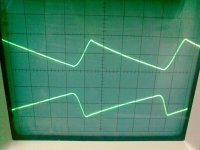Just make sure your output doesnt have a dc bias to it, because this amp will amplify from DC up.
thanks for the replies. But what do u mean by a DC bias to it?
hi,
By using the power amplifier below.
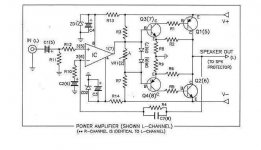
when i measure the collector pin of both Q3 & Q4 using a scope i get the waveform below. This waveform is outputted when the volume is low.
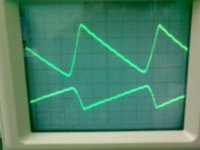
when i tune the volume slightly higher.I get this.
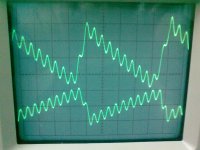
And the pic below show the comparison between Q3(Collector) & Q1 (collector).
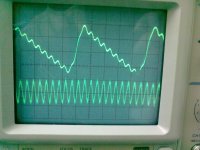
From the first waveform, i can see that the Voltage level of Q3(C) is complement with Q4(C). Does this mean the push-pull characteristic?
Another ques is how could the voltage go up and rapidly down in such a way? which part is controlling the up and down.
When i tune the volume lower there is no signal inside the triangle waveform.But when i tune the volume higher it seems like the audio signal which i inputted carry by the triangle waveform. Can someone explain on this?
thank you.
By using the power amplifier below.

when i measure the collector pin of both Q3 & Q4 using a scope i get the waveform below. This waveform is outputted when the volume is low.

when i tune the volume slightly higher.I get this.

And the pic below show the comparison between Q3(Collector) & Q1 (collector).

From the first waveform, i can see that the Voltage level of Q3(C) is complement with Q4(C). Does this mean the push-pull characteristic?
Another ques is how could the voltage go up and rapidly down in such a way? which part is controlling the up and down.
When i tune the volume lower there is no signal inside the triangle waveform.But when i tune the volume higher it seems like the audio signal which i inputted carry by the triangle waveform. Can someone explain on this?
thank you.
By using the power amplifier below.
Attachment 161710
when i measure the collector pin of both Q3 & Q4 using a scope i get the waveform below. This waveform is outputted when the volume is low.
Attachment 161707
when i tune the volume slightly higher.I get this.
Attachment 161708
And the pic below show the comparison between Q3(Collector) & Q1 (collector).
Attachment 161709
From the first waveform, i can see that the Voltage level of Q3(C) is complement with Q4(C). Does this mean the push-pull characteristic?
Another ques is how could the voltage go up and rapidly down in such a way? which part is controlling the up and down.
When i tune the volume lower there is no signal inside the triangle waveform.But when i tune the volume higher it seems like the audio signal which i inputted carry by the triangle waveform. Can someone explain on this?
still waiting..anyone can help to explain?thanks
I need additional the waveform of input signal for reference. And I need the waveform of the residual AC signale between the pos rail and GND so as neg. rail and GND.
If you have already a sine wave signal as input, your device is an oscillator instead an amplifier - I guess.
Wiring management and mass (GND) management by such amplifier is always critical. Without experience in most cases you will have an unwanted oscillator effect.
The problem could be from filter cap in combination with some other things. But not allone from filter cap, because the high frequency saw tooth isn't to see here.when i tune the volume slightly higher.I get this.
View attachment 161708
And the pic below show the comparison between Q3(Collector) & Q1 (collector).
View attachment 161709
The showing of a second wave form with higher frequency by higher volume is for me clearly indicator for parasitic oscillation through unwanted influences of one or several faulties by wiring and PCB design. Check out the links from my first answer here and compare your device with that one from the URL of Spain kit supplier.
And the mentioned missing parts by post #11 this oscillation by higher volume adjust can't actually cause.
Last edited:
but the output to speaker is ok,it is shown in the 3rd waveform. The sawtooth has been cancel off at the final output.Although i don't know how does it be canceled off. But it really turns up to be a fine sine wave at the output.
but the output to speaker is ok,it is shown in the 3rd waveform.
In which condition?
With or without load?
With or without Boucherot network to GND?
In which input condition?
Input short or Input open?
Which input signal?
Some other boundary conditions are very important to know for deliver helpful advices.
Please note: even perfectly designed and built amplifiers can oscillate without loudspeaker load or Boucherot network to GND.
For certainly circuit concepts, it can also be reversed. But in such cases there are hugh design/wiring errors.
I recommend to buy some books about amplifiers. Any suggestions you will find there:
http://www.diyaudio.com/forums/solid-state/158055-best-books-about-solid-state-amplifiers.html
From that one of J.Curl's post #7 I would start.
with load.i connect the output to 1 pair of speaker(4ohm). i inputted 1khz sine wave using a signal generator.
thanks for the advices.
thanks for the advices.
The DIY kit i bought which is this New Page 1 has a 40watt + 40watt transistorised stereo power Amp. Is it suitable to connect it to a pair of speaker with a spec of max power 200Watt, nominal power 80watt, impedance 4ohm? usually how do we know that what type of spec of the speaker should be use for different type of power amplifier kit?
thanks.
thanks.
You can hook up a 1 watt amp to a 200 watt speaker if you really wanted to.
Just make sure your amp can safely drive 4 ohm loads.
Just make sure your amp can safely drive 4 ohm loads.
Yea, thats very odd. What size is your filter cap?
can you measure your current consumption from the power supply
The amount of ripple in your power rails is way too high.
The amount of ripple in your power rails is way too high.
can you measure your current consumption from the power supply
The amount of ripple in your power rails is way too high.
I looked at that too, but there's no scale on the scope. How much is the ripple actually? it may be fraction of volts.
jd
- Status
- Not open for further replies.
- Home
- Amplifiers
- Solid State
- Is this consider a push pull amplifier?
